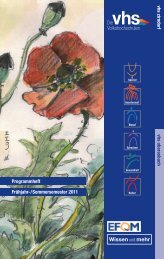Der NEUE Katalog ist da! - PRO PUBLIC GmbH
Der NEUE Katalog ist da! - PRO PUBLIC GmbH
Der NEUE Katalog ist da! - PRO PUBLIC GmbH
You also want an ePaper? Increase the reach of your titles
YUMPU automatically turns print PDFs into web optimized ePapers that Google loves.
1<br />
Serum-free Systems<br />
Endothelial cells line blood vessels and the internal cavities<br />
of the heart. They display a flattened, polygonal form and<br />
adhere to each other by desmosomes and tight-junctions.<br />
With a total number of about 10 12 cells, the endothelium<br />
is one of the biggest organs of the body and plays a key<br />
role in many physiological and pathophysiological processes.<br />
A number of factors control proliferation and apoptosis<br />
of endothelial cells, thereby regulating maintenance, degeneration,<br />
or regeneration of blood vessels.<br />
New blood vessel formation occurs via angiogenesis or<br />
vasculogenesis, a process restricted to embryonic development.<br />
In 1997, postnatal vasculogenesis has been proposed<br />
as an important mechanism for angiogenesis via<br />
blood or bone marrow derived circulating progenitor<br />
endothelial cells (PEC) (Asahara et al, Science 1997). PEC<br />
have been extensively studied as potential cell therapy for<br />
the repair of <strong>da</strong>maged blood vessels. Animal studies clearly<br />
demonstrated that admin<strong>ist</strong>ration of PEC partially rescued<br />
cardiovascular dysfuntion or myocardial injury with evidence<br />
for PEC contribution to new vessel growth.<br />
While controversy ex<strong>ist</strong>s as to the identity of endothelial<br />
cell progenitors, recently a PEC population has been<br />
identified which shows expression of typical endothelial<br />
as well as progenitor markers (Ingram et al, Blood.<br />
2004;104:2752-2760). Importantly, these cells have been<br />
tested for a high proliferative potential in clonogenic assays<br />
and characterized by formation of functional blood vessels<br />
in vivo (Yoder et al, Blood. 2007;109:1801-1809).<br />
With endothelial cell progenitors rapidly moving into the<br />
field of interest for vascular tissue engineering with potential<br />
therapeutic application, the presence of whole animal<br />
serum or animal-derived components in culture media is<br />
undesirable for a cell therapeutic approach.<br />
Product Description:<br />
PowerStem PEC1 ready-to-use (P04-777500) is a specially<br />
developed medium for a serum- and xeno-free in vitro<br />
culture of human progenitor endothelial cells (hPEC)<br />
containing all components necessary for optimal colony<br />
formation, clonogenic growth, and rapid proliferation. It is<br />
designed for use in an incubator at 37 °C with a 5% CO2<br />
atmosphere. Please avoid repeated warming of complete<br />
medium. Prepare only the amount needed in a separate<br />
sterile tube. For a T25 cell culture flask it is recommended<br />
to use 5 ml of PowerStem PEC1. For smaller or larger culture<br />
area, please adjust volume accordingly. When cells<br />
have been thawed, change the medium after 24 h to<br />
remove un-attached cells; for maintenance and propagation,<br />
change the medium every two or three <strong>da</strong>ys; for<br />
cultures close to confluence or for maximum proliferative<br />
response, it is recommended to use more medium or more<br />
frequent changes. Store at 2 - 8 °C in the <strong>da</strong>rk. Expiry:<br />
3 months.<br />
1.63<br />
Serum-freie Systeme<br />
PowerStem PEC1/PowerStem PEC1<br />
Endothelzellen kleiden Blutgefäße und <strong>da</strong>s Innere der<br />
Herzhöhlen aus. Sie haben eine stark abgeflachte, polygonale<br />
Form und ruhen me<strong>ist</strong>ens auf einer Basalmembran.<br />
Das Endothel <strong>ist</strong> mit ca. 10 12 Zellen eines der größten<br />
Organe des Körpers und spielt bei vielen physiologischen<br />
und pathophysiologischen Prozessen eine Schlüsselrolle.<br />
Eine Vielzahl löslicher Faktoren steuern Proliferation und<br />
Apoptose von Endothelzellen und regulieren auf diese<br />
Weise zum Beispiel die Neu- oder Rückbildung von Blutgefäßen.<br />
Die Bildung neuer Blutgefäße erfolgt durch Angiogenese<br />
oder Vaskulogenese. Letzteres wurde lange als ein auf die<br />
Embryonal-Entwicklung beschränkter Prozess betrachtet.<br />
Im Jahre 1997 wurde die postnatale Vaskulogenese als<br />
ein wichtiger Mechanismus der Blutgefäßneubildung<br />
beschrieben. Dafür sollen aus dem Blut oder dem Knochenmark<br />
stammende endotheliale Progenitorzellen (PEC) verantwortlich<br />
sein (Asahara et al, Science 1997). Als Folge<br />
dieser Entdeckung wurden PEC intensiv als mögliche Zelltherapie<br />
zur Reparatur geschädigter Blutgefäße untersucht.<br />
Die Anwendung von PEC in Tierversuchen zeigte<br />
eine Verbesserung der kardiovaskulären Dysfunktion oder<br />
eine Reparatur von Herzinfarkten mit Anzeichen für eine<br />
Beteiligung von PEC bei Blutgefäßneubildung.<br />
Es bestehen zurzeit noch unterschiedliche Meinungen<br />
bezüglich der Identität von PEC. Umfassende Vergleichsanalysen<br />
haben eine neue PEC Population definiert, die<br />
sowohl typische endotheliale als auch Progenitorzell-Marker<br />
exprimiert (Ingram et al, Blood. 2004). Zusätzlich wurde<br />
ein hohes klonogenes Proliferationspotential und die Bildung<br />
funktionaler Blutgefäße in vivo für diese Zellen nachgewiesen<br />
(Yoder et al, Blood. 2007).<br />
Da endotheliale Progenitorzellen verstärkt ins Blickfeld<br />
der therapeutischen Anwendung beim vaskulären Tissue<br />
Engineering rücken, <strong>ist</strong> die Anwesenheit von Serum oder<br />
sonstigen tierischen Bestandteilen in Zellkulturmedien bei<br />
der Erforschung möglicher zelltherapeutischer Ansätze unerwünscht.<br />
Produktbeschreibung:<br />
PowerStem PEC1 ready-to-use (P04-777500) <strong>ist</strong> ein gebrauchsfertiges,<br />
serum-freies Komplettmedium für die in<br />
vitro Kultur humaner endothelialer Progenitorzellen (hPEC)<br />
unter Xeno-freien Bedingungen. Es enthält alle Komponenten<br />
für optimale Koloniebildung, klonogenes Wachstum<br />
und eine schnelle Expansion. PowerStem PEC1 <strong>ist</strong> formuliert<br />
für die Verwendung in einem Brutschrank mit 5% CO2.<br />
Bitte vermeiden Sie wiederholtes Erwärmen und Abkühlen.<br />
Die für <strong>da</strong>s Arbeiten benötigte Menge an Medium sollte<br />
in einem separaten, sterilen Gefäß erwärmt werden. Für<br />
eine T-25 Flasche benötigen Sie z.B. 5 ml Medium, bei<br />
anderen Kulturgefäßen der Wachstumsfläche entsprechend<br />
mehr oder weniger. Es wird empfohlen, <strong>da</strong>s Medium<br />
alle 2-3 Tage zu wechseln. Direkt nach dem Auftauen von<br />
Zellen sollte <strong>da</strong>s Medium nach ca. 24 h gewechselt werden.<br />
Bei Erreichen der Konfluenz oder für maximale Proliferation<br />
empfiehlt sich ein häufigerer Medienwechsel bzw. die<br />
Zugabe entsprechend größerer Menge. Lagertemperatur:<br />
2 - 8 °C. Haltbarkeit: 3 Monate.<br />
BIOTECH <strong>GmbH</strong>





